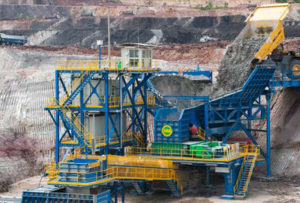
There are two main issues to consider when it comes to the environmental impacts of a mine:
- The erection of plant, and its ongoing effect on its surrounds; and
- How the site is rehabilitated after the mine has been decommissioned.
A fixed plant typically requires land being cleared, walls being built and roads being established. Then there is the plant assembly itself, which involves conveyor belts being constructed, material processing equipment put in place and draglines being set up, plus a range of peripheral considerations.
Sizing ore or minerals is a key component in mining operations. Setting up a permanent plant to allow processing and its affiliated operations can have a massive impact on the environment.
First, traditional plant used for high capacity crushing is enormous – it can be up to 32 metres high. This means that even before a site is set up, fixed plant has a large carbon footprint due to the amount of material used to construct it.
Then there is the construction of the plant onsite, which can take up large tracts of land due to the equipment itself plus support structures including buildings.
Also, there are the concrete or Reinforced Earth (RE) walls that are necessary for permanent plant. Not only can they have a negative impact on the environment, but they also take time to establish and require a lot of resources to complete.
Finally, there is the rehabilitation of the site. Costs can run into millions of dollars, depending on how much impact a mine has had on an area. If care has not been taken, or the plant has operated outside its agreed parameters, it means the approved remedies decided between state/local government bodies and the mining company might not be met.
Australian state and federal legislation puts the onus on mining companies to return a site to as close to its original condition as possible. The more permanent plant and installations that are set up initially, the more that has to be deconstructed and managed.
Minimising The Carbon Footprint
A piece of equipment that could help alleviate the impact on the environment is a Semi-Mobile Sizer Station from MMD.
For a start, they can be smaller than a permanent station – available in a range of modular designs, currently with a maximum height of 17 metres.
It also negates the need for concrete retaining walls because a fabricated truck bridge is used instead. Like the Semi-Mobile Sizer Station, the truck bridge can be deployed again and again, so there is no fixed plant to dispose of once the mine’s life expires.
Finally, there is no decommissioning of plant. With permanent plant there are concrete walls to be removed and earth landscaped. The area where the plant was located has to be rehabilitated with plants, trees, dirt and other stipulations as agreed.
With a Semi-Mobile Sizer Station, the plant is not in place long enough to cause as much impact. Furthermore, when it comes to moving to a different site, it is simply a case of picking up the unit on a transporter and moving it to its next location. There is no need for plant breakdown, crushing of concrete, or large fleets of trucks to take equipment away.
With modular construction and minimal maintenance, MMD equipment provides greener, more cost effective-solutions for today’s mines.
To read more on the environmental benefits of Semi-Mobile Sizer Stations, view MMD Australia’s whitepaper here.
